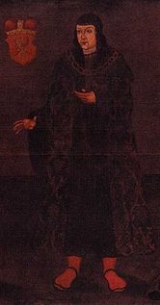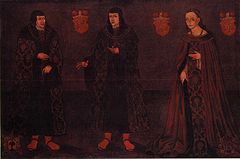
Janusz III of Masovia
Encyclopedia
Janusz III Mazowiecki (1502–1526) was a Polish duke of Masovia
, last male of the Masovian Piast dynasty
. Son of Konrad III Rudy
. Until 1518 Masovia was under regency
of his mother Anna Radziwiłł, then he was a co-regent with his brother Stanisław until Stanisław's death in 1524. After his heirless death in 1526, the Duchy of Masovia
was annexed into the Kingdom of Poland
.
and Anna Radziwiłł, born in winter 1502. After his father's death in 1503 Janusz and his brother Stanisław inhertited the Czersk Land, and with support of Alexander Jagiellon
, the throne of Duchy of Masovia
, but due to their young age the throne was taken by their mother, Anna, who became the regent
.
In 1518, both brothers were invited to the wedding of Sigismund I the Old
and Bona Sforza
. Janusz and Stanisław fought on the Polish side during the Polish-Teutonic War (1519–1521).
Anna reigned until 1518, past the time both brothers reached the age in which they could became rulers. Eventually the disapproval of local nobility resulted in her officially transferring the power to her sons, but in fact she continued to rule the Duchy until 1522.
After their mother's death, both brothers quickly became known for their love of "women and wine". Both brothers acted as co-rulers until Stanisław's death in 1524. However Janusz ruled only until his death in the night of 9 to 10 March, 1526. He was buried in St. John's Cathedral, Warsaw
. With his death, the male line of Masovian Piasts, originating with Siemowit III of Masovia
died out.
The death of both brothers caused unrest, as accusations that they were murdered became widespread. Eventually, King Sigismund himself looked into the matter, and concluded that there was no foul play. A contemporary historian, Marcin Bielski
, suggested that both brothers died due to alcohol poisoning; others suggested tuberculosis
.
Soon after his death, the Duchy of Masovia
was annexed into the kingdom of Poland
, despite resistance from some of the Masovian nobility. They tried to retain their independence and argued that the Duchy should be inherited by the female relatives (such as Anna
or Sophia of Masovia
). The Polish king refused to recognize their demands, and stood by the agreements that made him the heir to the Duchy, reuniting it with Poland. The Duchy, which would become a significant asset of the Polish Jagiellon dynasty
, would retain some autonomy till 1576.
 He is one of the characters on the famous painting by Jan Matejko
He is one of the characters on the famous painting by Jan Matejko
, Prussian Homage
.
Dukes of Masovia
The Dukes of Masovia were a line of the Piast dynasty who ruled in Masovia. The following is a list of all rulers of the Duchy of Masovia and its parts...
, last male of the Masovian Piast dynasty
Piast dynasty
The Piast dynasty was the first historical ruling dynasty of Poland. It began with the semi-legendary Piast Kołodziej . The first historical ruler was Duke Mieszko I . The Piasts' royal rule in Poland ended in 1370 with the death of king Casimir the Great...
. Son of Konrad III Rudy
Konrad III Rudy
Konrad III Rudy was a Polish duke of Masovia.He reunited most of Masovia still not controlled by Kingdom of Poland, including Płock, Płońsk, Czersk, Wyszogród and Warsaw....
. Until 1518 Masovia was under regency
Regent
A regent, from the Latin regens "one who reigns", is a person selected to act as head of state because the ruler is a minor, not present, or debilitated. Currently there are only two ruling Regencies in the world, sovereign Liechtenstein and the Malaysian constitutive state of Terengganu...
of his mother Anna Radziwiłł, then he was a co-regent with his brother Stanisław until Stanisław's death in 1524. After his heirless death in 1526, the Duchy of Masovia
Duchy of Masovia
The Duchy of Masovia with its capital at Płock was a medieval duchy formed when the Polish Kingdom of the Piasts fragmented in 1138. It was located in the historic Masovian region of northeastern Poland...
was annexed into the Kingdom of Poland
Kingdom of Poland (1385–1569)
The Kingdom of Poland of the Jagiellons was the Polish state created by the accession of Jogaila , Grand Duke of Lithuania, to the Polish throne in 1386. The Union of Krewo or Krėva Act, united Poland and Lithuania under the rule of a single monarch...
.
Biography
Janusz was the younger son of Konrad III RudyKonrad III Rudy
Konrad III Rudy was a Polish duke of Masovia.He reunited most of Masovia still not controlled by Kingdom of Poland, including Płock, Płońsk, Czersk, Wyszogród and Warsaw....
and Anna Radziwiłł, born in winter 1502. After his father's death in 1503 Janusz and his brother Stanisław inhertited the Czersk Land, and with support of Alexander Jagiellon
Alexander Jagiellon
Alexander of the House of Jagiellon was the Grand Duke of Lithuania and later also King of Poland. He was the fourth son of Casimir IV Jagiellon...
, the throne of Duchy of Masovia
Duchy of Masovia
The Duchy of Masovia with its capital at Płock was a medieval duchy formed when the Polish Kingdom of the Piasts fragmented in 1138. It was located in the historic Masovian region of northeastern Poland...
, but due to their young age the throne was taken by their mother, Anna, who became the regent
Regent
A regent, from the Latin regens "one who reigns", is a person selected to act as head of state because the ruler is a minor, not present, or debilitated. Currently there are only two ruling Regencies in the world, sovereign Liechtenstein and the Malaysian constitutive state of Terengganu...
.
In 1518, both brothers were invited to the wedding of Sigismund I the Old
Sigismund I the Old
Sigismund I of Poland , of the Jagiellon dynasty, reigned as King of Poland and also as the Grand Duke of Lithuania from 1506 until 1548...
and Bona Sforza
Bona Sforza
Bona Sforza was a member of the powerful Milanese House of Sforza. In 1518, she became the second wife of Sigismund I the Old, the King of Poland and Grand Duke of Lithuania, and became the Queen of Poland and Grand Duchess of Lithuania.She was the third child of Gian Galeazzo Sforza and his wife...
. Janusz and Stanisław fought on the Polish side during the Polish-Teutonic War (1519–1521).
Anna reigned until 1518, past the time both brothers reached the age in which they could became rulers. Eventually the disapproval of local nobility resulted in her officially transferring the power to her sons, but in fact she continued to rule the Duchy until 1522.
After their mother's death, both brothers quickly became known for their love of "women and wine". Both brothers acted as co-rulers until Stanisław's death in 1524. However Janusz ruled only until his death in the night of 9 to 10 March, 1526. He was buried in St. John's Cathedral, Warsaw
St. John's Cathedral, Warsaw
St. John's Archcathedral in Warsaw is a Catholic church in Warsaw's Old Town, is the only one archcathedral in Warszawa, the other 3 are cathedrals in the Polish capital. St. John's stands immediately adjacent to Warsaw's Jesuit church, and is one of the oldest churches in the city and the main...
. With his death, the male line of Masovian Piasts, originating with Siemowit III of Masovia
Siemowit III of Masovia
Siemowit III of Masovia was a prince of Masovia and a co-regent of the lands of Warsaw, Czersk, Rawa, Gostynin and other parts of Masovia.- Life :...
died out.
The death of both brothers caused unrest, as accusations that they were murdered became widespread. Eventually, King Sigismund himself looked into the matter, and concluded that there was no foul play. A contemporary historian, Marcin Bielski
Marcin Bielski
Marcin Bielski was a Polish chronicler and satirical poet. He was born of noble parentage on the patrimonial estate of Biała, Pajęczno County , in the Polish province of Sieradz. The name Wolski is derived from his estate at Wola...
, suggested that both brothers died due to alcohol poisoning; others suggested tuberculosis
Tuberculosis
Tuberculosis, MTB, or TB is a common, and in many cases lethal, infectious disease caused by various strains of mycobacteria, usually Mycobacterium tuberculosis. Tuberculosis usually attacks the lungs but can also affect other parts of the body...
.
Soon after his death, the Duchy of Masovia
Duchy of Masovia
The Duchy of Masovia with its capital at Płock was a medieval duchy formed when the Polish Kingdom of the Piasts fragmented in 1138. It was located in the historic Masovian region of northeastern Poland...
was annexed into the kingdom of Poland
Kingdom of Poland (1385–1569)
The Kingdom of Poland of the Jagiellons was the Polish state created by the accession of Jogaila , Grand Duke of Lithuania, to the Polish throne in 1386. The Union of Krewo or Krėva Act, united Poland and Lithuania under the rule of a single monarch...
, despite resistance from some of the Masovian nobility. They tried to retain their independence and argued that the Duchy should be inherited by the female relatives (such as Anna
Anna of Masovia
Anna of Masovia was Princess of Mazovia and a member of the House of Piast. She was the last representative of the line of Masovian-Piast....
or Sophia of Masovia
Sophia of Masovia
Sophia of Masovia was a Princess of Masovia, daughter of Konrad III Rudy, Duke of Masovia and his Anna Radziwiłł. She was a member of the House of Piast....
). The Polish king refused to recognize their demands, and stood by the agreements that made him the heir to the Duchy, reuniting it with Poland. The Duchy, which would become a significant asset of the Polish Jagiellon dynasty
Jagiellon dynasty
The Jagiellonian dynasty was a royal dynasty originating from the Lithuanian House of Gediminas dynasty that reigned in Central European countries between the 14th and 16th century...
, would retain some autonomy till 1576.

Jan Matejko
Jan Matejko was a Polish painter known for paintings of notable historical Polish political and military events. His most famous works include oil on canvas paintings like Battle of Grunwald, paintings of numerous other battles and court scenes, and a gallery of Polish kings...
, Prussian Homage
Prussian Homage (painting)
The Prussian Homage is an oil on canvas painting by Polish painter Jan Matejko painted between 1879 and 1882 in Kraków, then part of Austria-Hungary. It depicts a tribute made by Albrecht Hohenzollern, the Duke of Prussia, to King Sigismund I the Old in the Kraków market square on 10 April 1525;...
.

